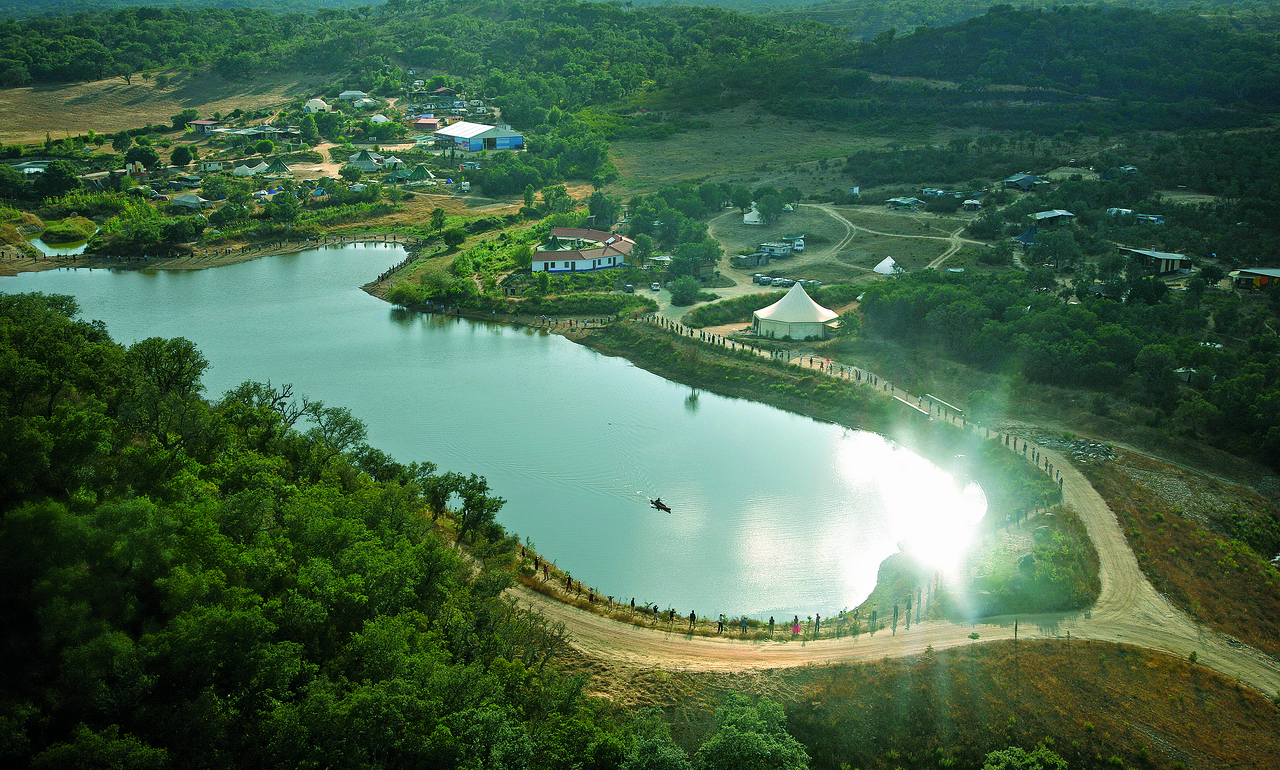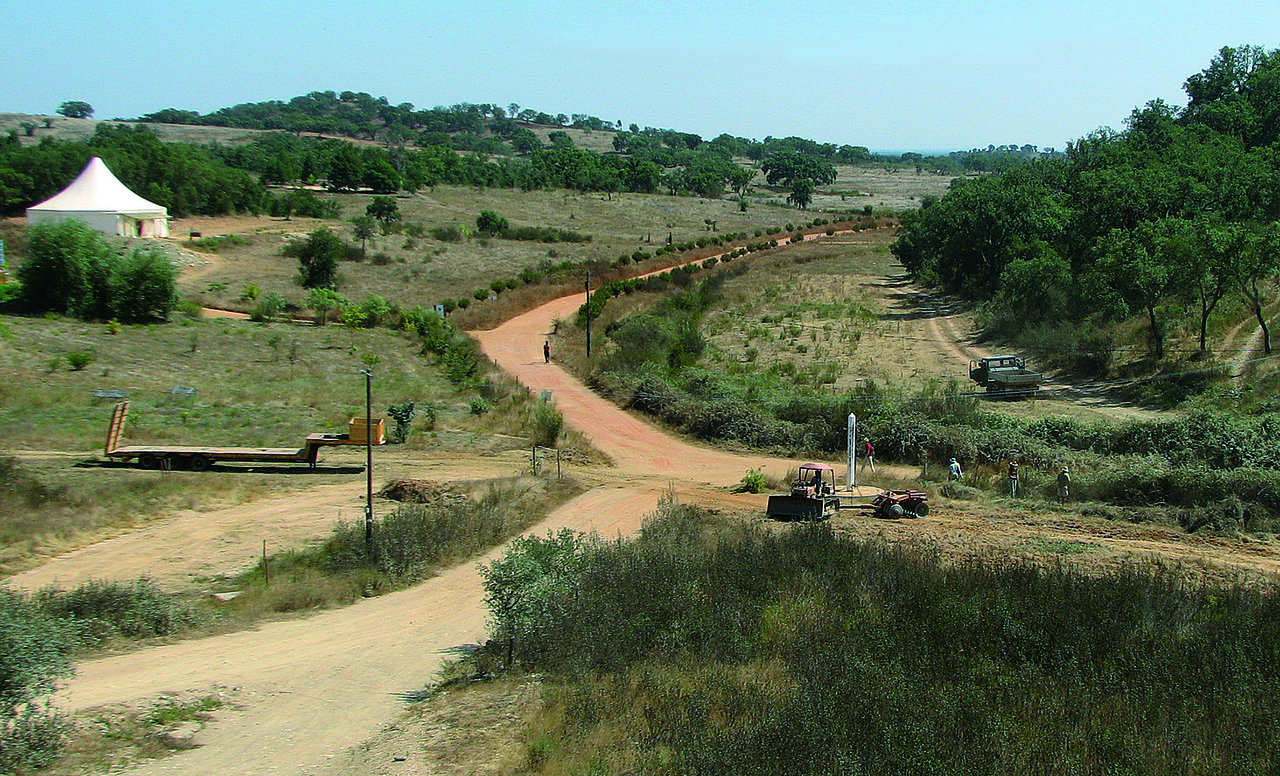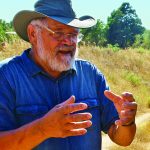Tamera at the lake
There is a community living in Tamera, in the municipality of Odemira in the Alentejo that now totals 200 people. With the assistance of the nature-friendly Austrian farmer Sepp Holzer, they created a model that demonstrates how productive agriculture based purely on rainwater retention is possible in a region that is dry in summer.
In March 2007, I was invited to Tamera for a consultation. The question was whether it would be possible to create a model site for the production of healthy food for 300 people in an area of 130 hectares of dry landscape in Southern Portugal. In brief, my answer was “Yes, easily.” Such beautiful and fertile land should be able to produce more food than the inhabitants need, so that they can sell the surplus, or leave it for the wild animals. I immediately saw that the summer droughts suffered in Portugal are not a natural phenomenon, but rather the result of decades, if not
centuries, of incorrect agricultural practices. The annual rainfall is not much less than that of Germany, but it is concentrated in the winter.
 copyright Nigel Dickinson[/caption]
copyright Nigel Dickinson[/caption]
In my consultations I always ask myself what I would do if I were the owner of this land. How would I intervene or act so that I could live well here as quickly as possible and so that I could use the resources of nature that are to be found here?
I very consciously say use – not abuse, or overuse. You must not be greedy and overuse nature. Instead, one must use it, and in all my consultations I try to show what is possible so that nature can work for me or for the owners.
In Tamera, I walked over the whole site with a group of about thirty people. All of the important decision makers were part of that walk. During the walk, I was already giving my suggestions. The most important thing is the water. Tamera was dry and dusty. The water was flowing down the creek, if it was flowing at all, which was only when it was raining. If not, the creek was dry and the surroundings were brown. The forest here was very sick.
I had already seen that this was the case not only in Tamera. On the drive here I had seen that the forests, the cork oaks, holm oaks and pines, were all in very poor condition. I have seen this in many different countries all around the world, including in Portugal.
I took the condition of the forest in Tamera and in the neighbourhood as a factor in my consultation. I also considered the steppe, the monocultures and the animal husbandry in Portugal, and I immediately had the idea that the Tamera Peace Community should create an exemplary pilot project. Its task would be to offer the neighbourhood and the whole country an example of a true alternative. But, for that, they would have to take big steps.
An Exemplary Project for Southern Europe
At first, my suggestions were considered to be too drastic. But I did not concede. Based on my experience in many other projects, including projects in other dry areas all over the world, I made it clear that for the work to be useful and meaningful it should be of exemplary quality. The suggested project of the water landscape, if it is meant to really work, must be implemented as a whole, according to the contours of the site. Anything less would create a landscape of small stagnant ponds, not a working natural design in the sense of landscape aesthetics. Water is a living being and must be able to move, otherwise it dies and festers. The majority of the decision-makers were very positive, even enthusiastic, and, after the summer high season, the project started.
A rough overview of my suggestion: at the entrance to the grounds, a road led through the middle of the village. It was the lowest point of the site, and the public road was made from clay and earth. For most of the year, whenever a car passed by, it raised a huge dust cloud. The exception was the rainy season, when there was so much mud it was almost impassible. I have seen this situation all over Europe. At the lowest point, there is always this road, and, next to it, houses are built. When the heavy rains come in the short rainy season, there is flood damage to the street and houses

Nature Shows Us How It Works
Nature itself shows us how to do better. The lowest points of the landscape belong to the water. So, my suggestion was to build natural dams with a barrier layer, starting right at the entrance. Behind them, the rainwater can collect. Tamera has a huge water catchment area of several hundred hectares and 500 to 600 millimetres of rain per year.
One of Tamera’s co-workers often gives visitors a beautiful calculation task: if the annual rainfall in Tamera were collected into containers of one cubic metre each, and arranged in a line, how far would the line reach? To the next village, five kilometres away? To the next small town, Odemira? Or would it even reach across the whole Iberian peninsula, to Barcelona? The last answer is the correct one!
You cannot imagine the amount of water that arrives here. You actually cannot call this land dry. I was sure that, despite the apparent drought, the lake would fill. And not only the first lake, but several.
That was my suggestion from the very beginning: a water landscape of at least ten retention ponds and lakes. The most important action one can take to protect drought-prone areas from desertification is to create enough retention spaces for the rainwater. When creating a water landscape one must take care that the curving dams are located at the naturally occurring narrow points on the site, to keep building costs low and to cooperate with nature instead of forcing lakes to develop in inappropriate places.
The natural shape of the landscape is not changed. The lakes are not additionally excavated, except for the deep zones. The natural contours fill with water. Because the design of the water landscape corresponds to the contours, natural retention ponds and lakes develop and collect the rainwater.
Decentralised water retention spaces raise the groundwater level so that neighbouring areas can regenerate. In this landscape of low hills, there is also no danger of landslides, so regulation of the water budget can take place from below and not from above with sprinklers. I also pointed out that water surfaces can be highly productive economic areas. Areas of water can be of higher value than agricultural land. They can be used for fishing, water plant cultivation, organic poultry farming, keeping water buffalo, and also for environmentally sensitive tourism and sports.
.
 Sepp Holzer is an ecological visionary and ‘rebel-farmer’ from Austria. He was an advisor to Tamera’s ecology team for several years. More information about him can be found at www.sepp-holzer.at and in his most recent book Desert or Paradise – Restoring Endangered Landscapes Using Water Management, including Lake and Pond Construction.
Sepp Holzer is an ecological visionary and ‘rebel-farmer’ from Austria. He was an advisor to Tamera’s ecology team for several years. More information about him can be found at www.sepp-holzer.at and in his most recent book Desert or Paradise – Restoring Endangered Landscapes Using Water Management, including Lake and Pond Construction.
 Eco123 Revista da Economia e Ecologia
Eco123 Revista da Economia e Ecologia

